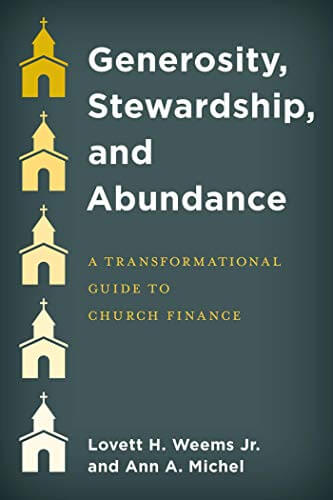Lovett Weems says a separate capital budget can help assure adequate funding for the upkeep of a church’s property, facilities, and equipment. In starting a capital budget, a church needs to assess its current and future needs and decide on the sources of income that will be dedicated to these needs.
When people think of church budgets, they usually have in mind the operating budget. There is another budget equally important to the vitality of your congregation — the capital budget. The Bible says when you build a tower you need to pay attention to the costs. It could have added that you need to prepare for some tower upkeep costs! Both operating and capital budgets are essential to effective ministry.
The goal of a capital budget is to ensure that the church’s property, facilities, and equipment are adequate to achieve the mission and are kept safe, accessible, and up to date. The defining characteristic of the capital budget is that it covers capital projects with a life longer than one year. In some churches, the “building fund” serves as the capital budget. Whatever it is called, there are two important questions for all churches to ask:
1. Do we have an ongoing plan to address each year our capital renewal and replacement needs?
If you are clear about your church’s mission, vision, and values, you are ready to ask what facilities you need to achieve today’s mission needs. Be very specific. Define how many worshipers your worship space needs to accommodate, as well as what type of space is needed for the way you worship now. How many classrooms, offices, etc., are needed given today’s realities? How much greeting space is needed? Where are our current goals and our facilities most in and out of alignment?
Then you can ask what facilities you currently have and their condition. Long established churches are often in buildings designed for far different circumstances than today. Asking if you have the right facilities is as important as inquiring about their condition.
You also need to know about current usage. For a relatively typical two-week period, simply record how many people are using each of your rooms and spaces during each hour of the day. You will need to involve several people with the logistics, but it really is as simple as recording a number for each hour of the day for two weeks.
Now you are ready to make a list of current and future needs. You will need to bring some order to this collection by organizing them into subject categories, such as:
- Health, safety, code compliance
- Accessibility
- Major systems (heating/cooling)
- Technology/sound systems
- Roofs
- Painting
- Renovation
- New construction
Next, prepare a chart with columns for five to 10 years. You already have your categories and issues under each category. First, place the highest priority projects in year one. Health, safety, and code compliance always come first. Second, divide large projects into units so that they can be spread across multiple years. Divide deferred maintenance projects into more manageable units. Determine a painting cycle and a technology replacement cycle. You can always delay or move up the replacement as needed.
Now focus on the next year to see what is both essential and feasible. Tentative cost estimates need to be assigned to each project. Be prepared for the total to surprise you! From all that needs to be done, determine what is most critical to accomplish with the resources you have or are likely to have. All other things will need shifting to future years.
2. Do we have sources of income that provide for these needs?
The biggest funding mistake most churches make is not having ongoing sources of income that provide at least some basic funds for capital expenditures. So, let’s think of as many income streams as possible that might flow into your capital fund. Here are sources of capital income that some churches use.
- The Capital Campaign is the mainstay of churches to handle capital needs. This is certainly the way churches normally build new facilities. Increasingly, as deferred maintenance needs mount, churches will combine them into a major renovation package funded by a campaign. Campaigns and special drives have their place and are usually essential for big ticket projects but not as the sole funding avenue.
- Loans are frequently used in combination with a capital campaign. Sometimes smaller loans are used to fund major unexpected damage or equipment replacement. Ideally, borrowing will become a smaller component of our capital plan, and loans will be short term rather than long term.
- Funds transferred from the operating budget. Many churches have a budget line that transfers a percentage of the operating budget each month into the capital fund. Try to start such a transfer in your next budget, even if you must start with a tiny percentage of the budget.
- When there are surplus operating funds at the end of the year, the capital fund is an excellent use for a portion of this money. Some churches put half into the capital fund and use the remaining half as a reserve for the operating budget.
- Some churches have an endowment or other permanent funds that produce earnings. This can provide a wonderful source of ongoing income for capital projects.
- Rental income and building use fees represent a growing source of income for churches. Often all this income goes to the operating budget. A more appropriate policy would divide the funds between the operating and capital budgets. Develop a reasonable formula by which some portion of rental income goes to the operating budget, but a larger part goes to the capital fund for upkeep of the property.
- Sometimes people simply make gifts to the capital or building funds. If people know they can make gifts to this fund in addition to their operating budget gifts, some will do so.
- Bequests are a common source of capital funds if the church has a policy that all or a portion of undesignated bequests go to the capital fund.
- Some other sources include memorial gifts, sale of capital assets, gifts in kind, and fundraisers.
Churches tend to do well at understanding and meeting their current needs. Churches do not do as well looking ahead to long-term needs that are often predictable. Being prudent and planning are very important because facilities are part of your ministry. You are simply taking funds given for the mission of your church and using them to ensure safe and usable facilities needed for the ministry.







